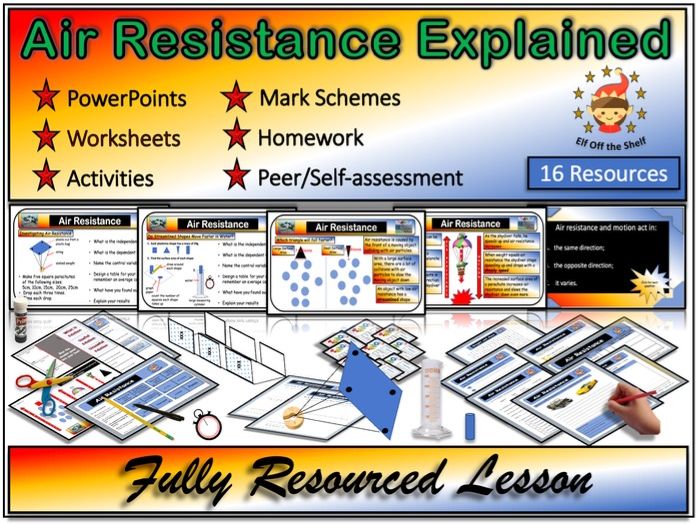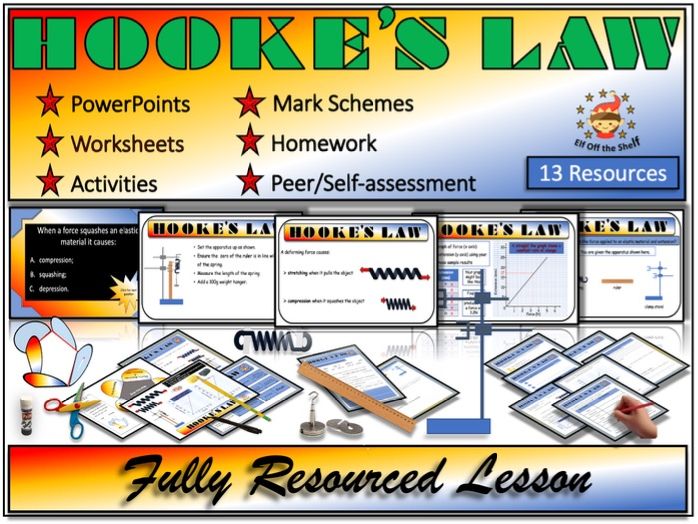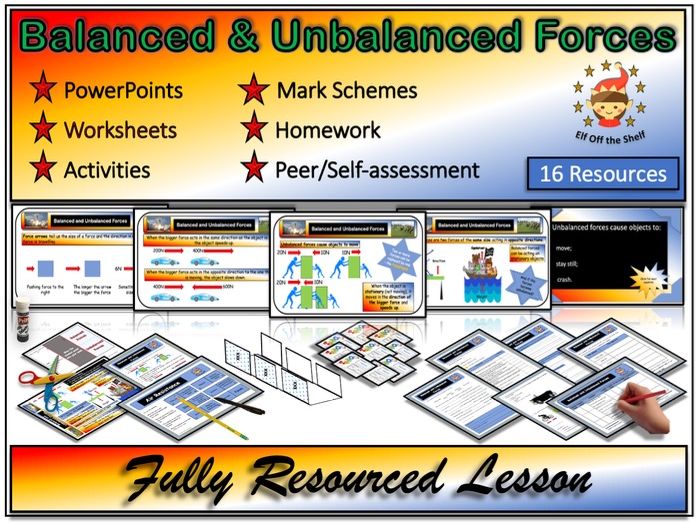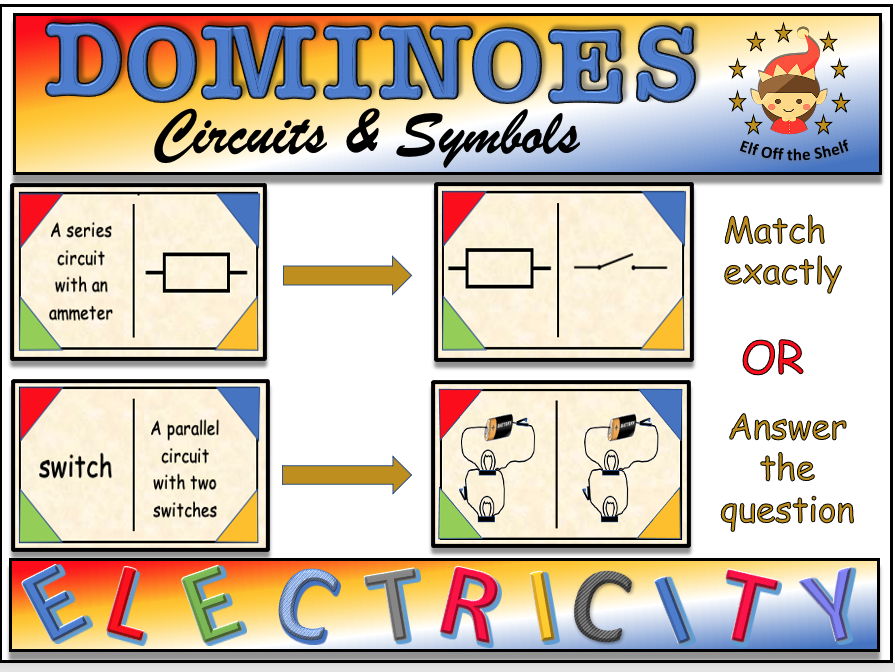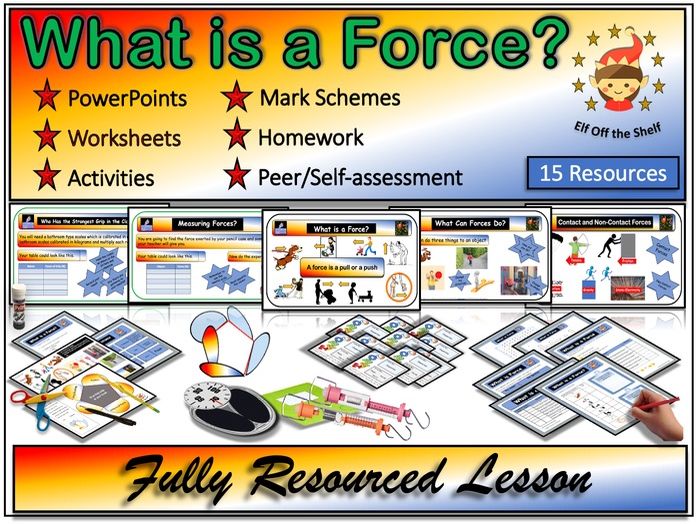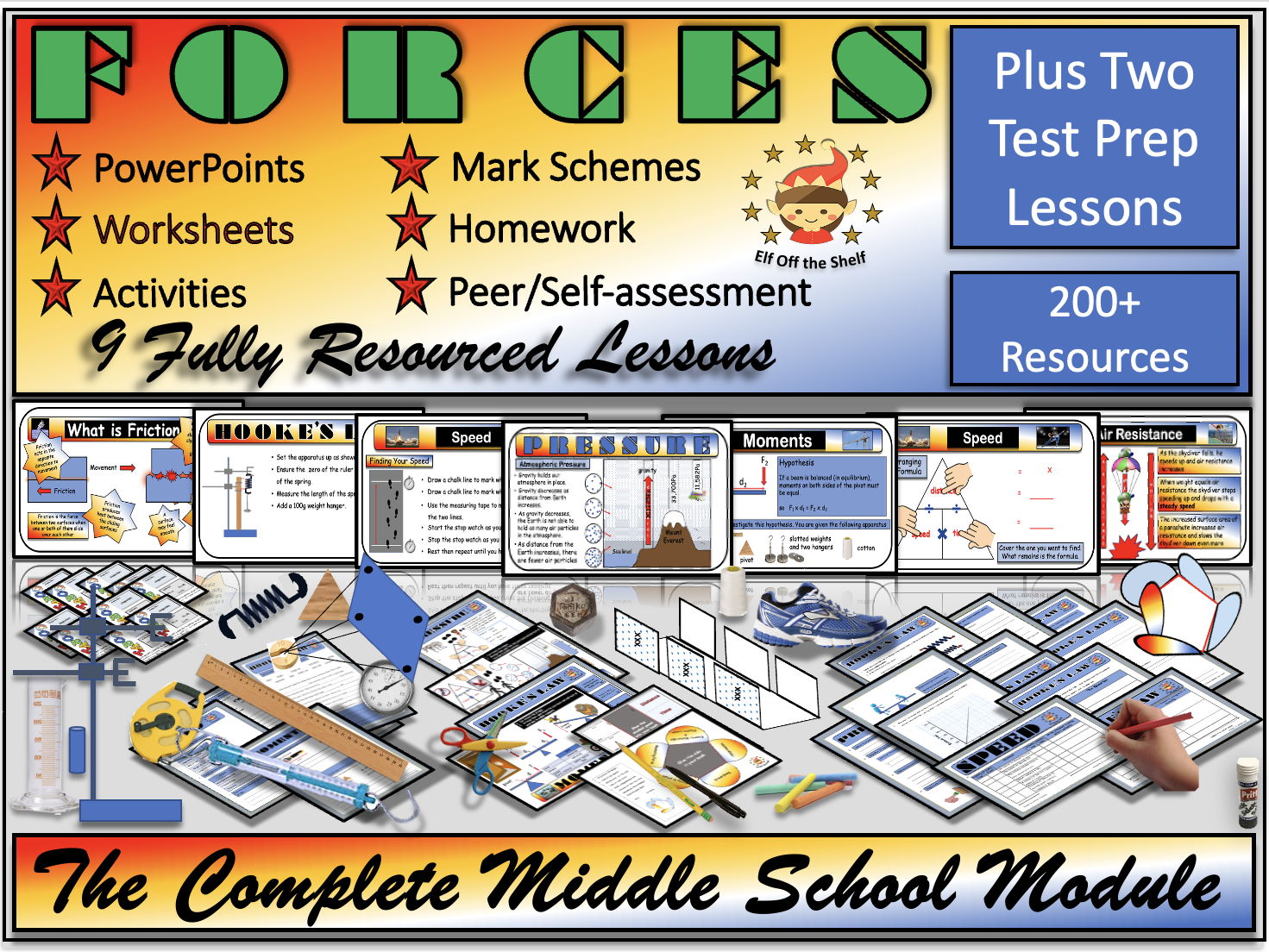525Uploads
152k+Views
95k+Downloads
Physics

Forces - Air Resistance Explained Fully Resourced Lesson KS3
A comprehensive and enjoyable explanation of the cause and effects of air resistance. To reinforce understanding, the engaging animated PowerPoint also includes two simple but exciting labs to investigate firstly the relationship between the surface area of a parachute and air resistance and secondly whether streamlined objects travel faster in water. Sets of results are provided for students to draw conclusions should apparatus not be available. In addition to the PowerPoint, this fully resourced topic comes with a collection of thirteen worksheets, guided notes, activities and homework. All answers are provided. A one – page flow chart lesson plan shows where logical choices can be made between resources if time requires.
This fully resourced lesson included an animated PowerPoint which:
makes understanding air resistance as collisions between the front of an object and air particles very easy to understand;
demonstrates why streamlined bodies reduce air resistance to travel faster;
provides a visual explanation of the relationship between acceleration due to gravity, air resistance, steady speed and why parachutes work;
investigates the relationship between the surface area of an object and air resistance;
proves that streamlined objects move faster through water.
What’s Included
Animated PowerPoint for teaching with exit ticket quiz
Answers PowerPoint
Flip it (pupil writes questions to given answers)
Anticipation Guides (combined starter and plenary)
Foldable
Cut-and-stick activity pupil uses to make their own notes)
Worksheet to support the PowerPoint (X3)
Fact sheet
Homework plus answers (x3)
Fact share worksheet
12 Taboo cards
Pupil progress self-assessment checklist
Exit Ticket
Suggested lesson plan showing choices possible between resources
All resources shown in these bundle are also available individually
Forces Module 1 - Force, Weight & Mass, Friction, Balanced & Unba
Forces Module 2 - Moments, Speed, Pressure & Hooke’s Law
The Complete Forces Module ( Module 2 + Module 2)
7 Game Compendium for Module 1
6 Game Compendium for Module 2
Forces - 13 Game Compendium
Lots more resources for forces at my shop?
Elf Off the Shelf Resources

Current Electricity - Conductors and Insulators Explained KS3
Explaining and demonstrating conductors and insulators in terms of high and low resistance as caused by the number of collisions between electrons and metal ions, the engaging and easy to follow animated PowerPoint then takes the student through designing a results table and test circuit. If apparatus is available the student can then test different materials themselves or alternatively use the results demonstrated in the PowerPoint in order to conclude that metals are conductors and non – metals are insulators.
Objective
To know that conductors conduct electricity and insulators do not.
To know that metals are conductors and non-metals are insulators.
To be able to design a test circuit and results table.
To explain why some materials are conductors or insulators in terms of the number of collisions between electrons and metal ions
.
Resources
Animated 11 slide PowerPoint - includes exit ticket /plenary quiz
Cut and stick
Anticipation guide(starter and plenary)
Flip It
Taboo Cards
Worksheet for practical
Fact sheet
Foldable
Fact Share Worksheet
Exit ticket template
ABC card template
4 Differentiated homework/classwork worksheets
Flow chart lesson plan
PowerPoint - answers/mark scheme.
With 13 printables, teachers can opt to bespoke their lesson to take account of the ability of their students and time available. A one page lesson plan flow chart shows where logical choices between resources can be made.
More High quality resources available from my shop.
[Elf Off the Shelf Shop

Current Electricity - Ohms Law Fully Resourced Lesson for KS3
Elf Off the Shelf Shop
Links to other resources in this series.
Current, Voltage and Resistance - What Are They?
Conductors and Insulators
Circuits and Symbols
Intro to Current Electricity 1
Intro to Current Electricity 2
Intro to Current Electricity 3
Current Electricity - Everything You Need

Forces, Weight, Friction, Air Resistance, Balanced & Unbalanced Forces Test Prep Lesson for KS3
Use this comprehensive and enjoyable quiz - based test prep lesson to review forces without students realising it’s test prep! At the end of the lesson, each student will take away with them a personalised list of facts that the quiz has identified they are unsure of in order that they can precisely target their review of forces at home.
What’s Covered
Definition, units and measurement of forces;
Mass and weight;
Friction;
Air resistance;
Balanced and unbalanced forces.
What is Included
54 Question PowerPoint
Answers PowerPoint
Student answer sheet
Fact Sheet
Suggested Lesson Plan
Students have some time to review the fact sheet either independently or with teacher.
Students use the answer sheet to write down the answers to the questions on the Question PowerPoint
Students check their answers against the answer PowerPoint
On the fact sheets, students circle the numbers of the questions they got wrong on the answer sheet and this gives them a revision list of facts to take away with them.
All resources shown in these bundle are also available individually
Forces Module 1 - Force, Weight & Mass, Friction, Balanced & Unba
Forces Module 2 - Moments, Speed, Pressure & Hooke’s Law
The Complete Forces Module ( Module 2 + Module 2)
7 Game Compendium for Module 1
6 Game Compendium for Module 2
Forces - 13 Game Compendium
Lots more resources for forces at my shop?
Elf Off the Shelf Resources

Forces - Hooke's Law Explained KS3
A comprehensive and engaging explanation of deformation, stretching, compression, elastic materials and elastic limit. The animated PowerPoint also guides the student through planning an investigation into whether there is a relationship between the force applied to an elastic material and the extension it produces (Hooke’s Law). A set of results is provided for students to draw a graph and a conclusion, should apparatus not be available for them to obtain their own. In addition to the PowerPoint, this fully resourced topic comes with a collection of thirteen worksheets, guided notes, activities and homework. All answers are provided. A one – page flow chart lesson plan shows where logical choices can be made between resources if time requires.
What’s Covered
This fully resourced lesson includes an animated PowerPoint which:
demonstrates a material changing its shape when acted on buy a force – deformation;
demonstrates stretching and compression;
demonstrates an elastic material regaining its shape after deformation;
demonstrates an elastic material failing to regain its shape after the elastic material is exceeded;
guides students through planning an investigation of Hooke’s Law;
demonstrates that, for elastic materials within their elastic limit a graph of extension against force is a straight line and confirms Hooke’s Law.
What’s Included
Animated PowerPoint for teaching with exit ticket quiz
Flip it (pupil writes questions to given answers)
Answers PowerPoint for easy self and peer assessment
Anticipation Guides (combined starter and plenary)
Foldable
Cut-and-stick activity pupil uses to make their own notes)
Worksheet to support the PowerPoint
Fact sheet
Homework plus answers (2)
Fact share worksheet
Pupil progress self-assessment checklist
Exit Ticket
Suggested lesson plan showing choices possible between resources
All resources shown in these bundle are also available individually
Forces Module 1 - Force, Weight & Mass, Friction, Balanced & Unba
Forces Module 2 - Moments, Speed, Pressure & Hooke’s Law
The Complete Forces Module ( Module 2 + Module 2)
7 Game Compendium for Module 1
6 Game Compendium for Module 2
Forces - 13 Game Compendium
Lots more resources for forces at my shop?
Elf Off the Shelf Resources

Current Electricity - Current Voltage and Resistance Explained KS3
This action-packed lesson introduces current as a flow of electrons and explains the relationship between current, voltage and resistance using the analogy of a diver using up energy obtained from food and giving off heat as they swim through pipes filled either with water (low resistance) or water and rocks (high resistance). The food as a source of energy is then replaced by the battery, the diver by the electron and the rocks by metal ions. Both scenarios are animated in the PowerPoint. This explanation is then extended to compare the resistance of long, short, thick and thin wires. The practical explores the conditions needed for current to flow in a circuit.
Objective
To know that current is a flow of electrons through a conductor when they are given energy or pushed by a voltage from the battery.
To know and explain how metal ions cause resistance.
To know and explain the comparative resistance of wires according to length and thickness.
To explain why electrons lose more heat passing through a high resistance conductor.
To know the conditions needed for current to flow in a circuit.
Resources
Animated 17 slide PowerPoint with exit ticket quiz
Cut and stick
Anticipation guide(starter and plenary)
Flip It
Taboo Cards
Worksheet for practical
Fact sheet
Foldable
Fact Share Worksheet
Exit ticket template
ABC card template
4 Differentiated homework/classwork worksheets
One-page Flow chart lesson plan
PowerPoint with answers /mark scheme
With 14 printables, teachers can opt to bespoke their lesson to take account of the ability of their students and time available. A one page lesson plan flow chart shows where logical choices between resources can be made.
Elf Off the Shelf Shop
Current Electricity - The Whole Module
Current Electricity - Dominoes
Current Electricity - Games Compendium

Forces - Balanced and Unbalanced Forces Explained Fully Resourced Lesson KS3
A comprehensive and enjoyable fully resourced lesson on balanced and unbalanced forces. An engaging animated PowerPoint explains and demonstrates resultant force, acceleration, deceleration, steady speed and upthrust. In addition to the PowerPoint, this fully resourced topic comes with a collection of thirteen worksheets, guided notes, activities and homework. All answers are provided. A one – page flow chart lesson plan shows where logical choices can be made between resources if time requires.
What’s Covered
Resultant force – two or more forces being replaced by one.
Balanced forces as two forces of equal size acting on opposite directions.
Balanced forces acting on stationary objects or resulting in steady speed.
Unbalanced forces produce acceleration or deceleration.
If the weight of an object equals the upthrust, it will float.
Resources
Animated PowerPoint for teaching with exit ticket quiz
Flip it (pupil writes questions to given answers)
Anticipation Guides (starter and plenary)
Foldable
Cut-and-stick activity
Worksheet (X3)
Fact sheet
Homework (x3) plus answer PowerPoint
Fact share worksheet
12 Taboo cards
Pupil progress self-assessment checklist
Exit Ticket
Suggested lesson plan showing choices possible between resources
Forces Module 1 - Force, Weight & Mass, Friction, Balanced & Unba
Forces Module 2 - Moments, Speed, Pressure & Hooke’s Law
The Complete Forces Module ( Module 2 + Module 2)
7 Game Compendium for Module 1
6 Game Compendium for Module 2
Forces - 13 Game Compendium
Lots more resources for forces at my shop?
Elf Off the Shelf Resources

Christmas Team Quest - Science Quiz KS3
An ideal science activity for the end of the Christmas term which promotes not only the concept of teamwork but also individually contributing to the success of a team. There are 56 science and Christmas trivia questions in this animated, interactive team quiz with built – in scoreboard for up to seven teams. All questions are pictorial and multiple choice.
Team Rounds
Each team will attempt their general knowledge team round of three questions. The answer to each question must be decided by the whole team. If a wrong answer is given, the next question goes to the first hand up and, if correct, that person’s team get to try the rest of the round.
Each team will also have to solve the clues to identify a well - known phrase or saying.
There are four lightning rounds in which team members consult to try to identify a slowly revealed person or landmark.
Individual Rounds
Four unscramble and identify rounds which consists of a picture which has been cut up and rearranged. This is an individual not a team round.
Memory Test – questions on eleven objects which cross the screen then disappear.
Memory Test – give coordinates of frogs which have moved around a pond.
Finally, the ten - question individual bonus round. This round allows flexibility in terms of the time the quiz takes as not all the questions have to be attempted. The quiz therefore can last between 40 and 50 minutes.
Why not have a look at my shop?
Elf Off the Shelf Shop

Current Electricity - Circuit and Symbols Dominoes KS3
A dominoes game with circuit symbols and descriptions, sketches and circuit diagrams of series and parallel circuits instead of numbers. Take your turn by matching a domino exactly or, for example, by matching a sketch with its circuit diagram. A fantastic way to consolidate learning at the end of the topic or during test prep. So enjoyable students will not realise they are learning
Prior Knowledge
Be able to recognise the symbols for a lamp, switch, voltmeter, ammeter, buzzer, motor and resistor.
Be able to match the description, sketch or circuit diagram for the same series circuit.
Be able to match the description, sketch or circuit diagram for the same parallel circuit.
What You Get
70 dominoes
Animated PowerPoint explaining the rules and how to play.
Rules of the Game
Each player selects seven dominoes from the top of the face-down pile and holds them in their hand like playing cards.
The player whose surname begins with a letter closest to the letter A starts and play proceed in a clockwise direction.
Dominos can be matched exactly, or a name can be matched with a symbol or descriptions, sketches and circuit diagrams can be matched.
If a player thinks a match is wrong they can challenge. If the challenger is correct, they give a card from their own hand to the challenged player. If the challenged player is correct, they give a card from their hand to the challenger.
If a player cannot play a domino, they pick up from the face down pile and can play if possible or add it to their hand.
Fully resourced lessons and money-saving bundles on current electricity are available.
Intro to Current Electricity 1
Intro to Current Electricity 2
Intro to Current Electricity 3
Intro to Current Electricity 4
Current Electricity KS3 – The Complete Module
Elf Off the Shelf Shop

Light - Shadows and Lunar and Solar Eclipses - Fully Resourced Lesson for KS3
A comprehensive and enjoyable fully resourced lesson on shadows and lunar and solar eclipses for middle school.
What’s Covered
The shadow of a point source only has an umbra but the shadow of a large point source has an umbra and a penumbra.
If the light source moves closer to the object, the shadow gets bigger.
If the object moves closer to the screen, the shadow gets smaller .
A lunar eclipse happens when the Earth stops all, or some, of the Sun’s light from reaching the Moon.
The Moon orbits the Earth once every 29.5 days.
When the entire moon passes through the Earths penumbra it appears slightly darker (penumbral eclipse).
If only part of the moon passes through the Earth’s umbra it is a partial eclipse.
A solar eclipse happens when the Moon stops all, or some, of the Sun’s light from reaching the Earth
A person on Earth, standing in the Moon’s umbra will see a total solar eclipse.
A person on Earth, standing in the Moon’s penumbra will see a partial solar eclipse.
When the Moon is at its furthest point from Earth, it no longer covers the whole surface of the Sun and an annular eclipse is seen from the umbra.
The Moon’s orbit is angled relative to the Earth so the Sun, Earth and Moon are not often in the alignment needed for a lunar Eclipse to occur.
When the entire moon passes through the Earths umbra it appears red due to refracted red light (total or umbral eclipse).
What’s Included
Animated PowerPoint for teaching with exit ticket quiz
Flip it (pupil writes questions to given answers)
Anticipation Guides (combined starter and plenary)
Foldable
Cut and stick activity.
Worksheet (x2) to support the PowerPoint
Fact sheet
Homework
Fact share worksheet
Pupil progress self-assessment checklist
Exit Ticket
Suggested lesson plan showing choices possible between resources
This pack contains fourteen printable resources as it is intended that the teacher uses them to build their own unique lesson to take account of student ability and time available. Literacy, oracy, self-assessment and peer assessment are all built in to the resources. These features are clearly marked on the comprehensive one-page flow chart lesson plan which shows where the logical choices between resources can be made.
More high quality resources available here.
Elf Off the Shelf Resources

Light - Dispersion, White Light and Colour Filters Fully Resourced Lesson KS3
A comprehensive and enjoyable fully resourced lesson on white light, dispersion and color filters.
What’s Covered
The order of the seven colours of the spectrum
Dispersion is the separation of white light into the seven different colors of the spectrum.
During dispersion, red light is refracted the least and violet light the most.
Dispersion is caused by the fact that each colour of light travels at a different speed in glass.
Red, green and blue are primary light colors.
Magenta, cyan and yellow are secondary light colors.
Mixing two primary light colours gives a secondary light color.
Mixing the three primary light colors gives white light.
An object only reflects light the same color as itself and absorbs all the others
Work out the color an object appears in different light color
What’s Included
Animated PowerPoint for teaching with exit ticket quiz
Flip it (pupil writes questions to given answers)
Anticipation Guides (combined starter and plenary)
Foldable
Cut and stick activity.
Worksheet (x4) to support the PowerPoint
Fact sheet
Homework
Fact share worksheet
Pupil progress self-assessment checklist
Exit Ticket
Suggested lesson plan showing choices possible between resources
This pack contains fourteen printable resources as it is intended that the teacher uses them to build their own unique lesson to take account of student ability and time available. Literacy, oracy, self-assessment and peer assessment are all built in to the resources. These features are clearly marked on the comprehensive one-page flow chart lesson plan which shows where the logical choices between resources can be made.
More high quality resources available here.
Elf Off the Shelf Resources

Light - Lenses, the Pinhole Camera, The Eye and the Camera- Fully Resourced Lesson KS3
A comprehensive and enjoyable, fully resourced lesson on refraction in lenses which includes the eye, the pinhole camera and the modern camera.
What’s Covered
Ray diagrams showing refraction in a concave and convex lens.
Convex lenses are used in magnifying glasses, telescopes and spectacles to correct long sight.
Concave lenses are used in lasers, flashlights, peepholes and spectacles to correct short sight.
Label the following structures on a diagram of the eye; retina; ciliary muscle; iris; pupil; lens; suspensory ligament; optic nerve.
Draw ray diagrams and explain how the eye sees distant and close objects.
Draw ray diagrams and explain how lenses are used to correct long and short sight.
Draw diagrams and explain how the iris controls the size of the pupil and therefore the amount of light which enters the eye.
Draw a ray diagram of the pinhole camera, know that the image is inverted sand diminished, moving the object closer enlarges the image and multiple pinholes produce multiple images
Label a diagram of the camera and explain how a picture is taken.
Explain the differences and similarities between the eye and the camera
What’s Included
Animated PowerPoint for teaching with exit ticket quiz
Flip it (pupil writes questions to given answers)
Anticipation Guide (combined starter and plenary)
Foldable
Cut and stick activity (x2)
Pinhole camera template
Worksheet to support the PowerPoint (x3)
Fact sheet (x3)
Homework
Fact share worksheet
Pupil progress self-assessment checklist
Exit Ticket
Suggested lesson plan showing choices possible between resources
This pack contains nineteen printable resources as it is intended that the teacher uses them to build their own unique lesson to take account of student ability and time available. Literacy, oracy, self-assessment and peer assessment are all built in to the resources. These features are clearly marked on the comprehensive one-page flow chart lesson plan which shows where the logical choices between resources can be made.
More high quality resources available here.
Elf Off the Shelf Resources

Light - Reflection in a Plane Mirror - Find the Pair Game KS3
This is an engaging and enjoyable memory game on reflection in plane mirrors. Pupils work in teams of three or four. Each team lays out their 42 cards face down in a square and take it in turn to turn over two cards. If the cards are a question and its correct answer, the pupil keeps the pair. If they are not a match they are turned face down and the next pupil gets a turn. This process continues until all cards are matched and the winner is the pupil with the most pairs.
If a team member thinks that the selectors pair is not a correct match, they can challenge.
Pupils are encouraged to check their books for the correct answer but the teacher also has a quick-check answer sheet. If the challenge is correct, the challenger keeps the pair.
**Included in this Pack. **
42 question and answer cards
Teacher’s answer sheet.
Instruction sheet
Preparation
Use double-sided printing to copy 1 set per group of 4 pupils.
Sheets could be laminated to enable year-on-year use.
Cut sheets into cards.
Prior Knowledge Required
Transparent, translucent and opaque materials
Luminous and non-luminous objects
Labelling the incident and reflected rays, the angles of incidence and reflection, the normal and the point of incidence
Virtual experiment to prove i = r
Ray diagram showing how the eye sees an image in a plane mirror
The image formed in a plane mirror is upright, virtual (appears to be formed behind the mirror) laterally inverted, the same size as the object and as far behind the mirror as the object is in front.
Ray diagram showing how the eye sees an image in a periscope
Specular and diffuse images
More high quality resources available here.
Elf Off the Shelf Resources

Forces - What is a Force? Fully Resourced Lesson KS3
This is a comprehensive and enjoyable introduction to forces for middle school science students. The fully resourced topic comes with an engaging animated PowerPoint and a collection of thirteen worksheets, guided notes, activities and homework. All answers are provided. A one – page flow chart lesson plan shows where logical choices can be made between resources if time requires.
What’s Covered
Force is a pull or a push with examples.
Arrows indicate the direction of force.
Contact and non-contact forces explained and examples
Forces can change an objects speed, direction or shape
The Newton and newtonmeter.
Real-life examples of forces.
Practical
The first simple practical gives pupils experience in reading scales as they find the weight of their pencil case and other items provided by the teacher. (selection of different objects and different size newtonmeters needed)
The second practical introduces an element of fun and competition by using a bathroom scales calibrated in Newtons (an ordinary bathroom scales can be used but multiply the reading in kilograms by 10) to find the person with the strongest grip in the class (photograph of how to do this shown on the PowerPoint)
What’s Included
Animated PowerPoint for teaching with exit ticket quiz
Flip it (pupil writes questions to given answers)
Anticipation Guides (combined starter and plenary)
Foldable
Cut-and-stick activity pupil uses to make their own notes)
Worksheet to support the PowerPoint
Fact sheet
Homework plus answers (x3)
Fact share worksheet
12 Taboo cards
Pupil progress self-assessment checklist
Exit Ticket
Suggested lesson plan showing choices possible between resources
All resources shown in these bundle are also available individually
Forces Module 1 - Force, Weight & Mass, Friction, Balanced & Unba
Forces Module 2 - Moments, Speed, Pressure & Hooke’s Law
The Complete Forces Module ( Module 2 + Module 2)
7 Game Compendium for Module 1
6 Game Compendium for Module 2
Forces - 13 Game Compendium
Lots more resources for forces at my shop?
Elf Off the Shelf Resources
Bundle

Forces - The Complete Module for KS3 9 Fully Resourced Topics Plus Two Test Prep Lessons
Nine, action-packed, engaging, enjoyable and fully resourced forces related topics including, weight and mass, friction, air resistance, balanced and unbalanced forces,
pressure, speed, moments (turning force) and Hooke’s Law.
Each topic has a fully animated PowerPoint and a collection of thirteen worksheets, guided notes, activities and homework. Answers and mark schemes for all worksheets and homework are given on PowerPoints to make self-assessment and peer assessment easier. Each topic comes with a one-page flow chart lesson plan showing where logical choices between resources can be made if necessary. In some of the topics the PowerPoint will also guide the student through planning an investigation and a set of results is provided in case apparatus is not available.
Fully Resourced Lessons
What is a Force
Weight and Mass Explained
What is Friction
Air Resistance Explained
Balanced and Unbalanced Forces Explained
Pressure in Air and Liquids Explained
Speed Explained
Moments or Turning Forced Explained
Hooke’s Law Explained
Please click on each resource in the bundle for a detailed description of what is covered and the resources included.
Also included are two quiz – based test prep lessons.
**Covered by Test Prep lesson 1 **
What is a Force
Weight and Mass
What is Friction
Air Resistance
Balanced and Unbalanced Forces
Covered by Test Prep Lesson 2
Pressure
Speed
Moments
Hooke’s Law
At the end of each of the quiz – based test prep lessons each student takes away with them a personalised list of facts which need further review so that they can target their work at home more effectively. This is test prep which students actually enjoy!
All resources shown in these bundle are also available individually
Forces Module 1 - Force, Weight & Mass, Friction, Balanced & Unba
Forces Module 2 - Moments, Speed, Pressure & Hooke’s Law
The Complete Forces Module ( Module 2 + Module 2)
7 Game Compendium for Module 1
6 Game Compendium for Module 2
Forces - 13 Game Compendium
Lots more resources for forces at my shop?
Elf Off the Shelf Resources

Mixtures-Pure Substances, Solutions, Dissolving and Solubility KS3
This fully resourced lesson on mixtures for middle school includes an animated PowerPoint which:
explains why elements and compounds are pure substance and mixtures are not;
explains the terms solute, solvent, solution, soluble and insoluble;
uses particle theory to explain why stirring, temperature and particle size affect the rate of dissolving;
provides the opportunity to plan an investigation into the effect of temperature on the rate of dissolving;
uses particle theory to explain dissolving, suspensions and saturated saturated solutions;
demonstrates extracting information from solubility curves;
What’s Included
Animated PowerPoint for teaching with exit ticket quiz and all answers to classwork and homework)
Flip it (pupil writes questions to given answers)
Anticipation Guides (combined starter and plenary)
Foldable (students use to make their own notes)
Cut-and-stick activity pupil uses to make their own notes)
Worksheet to support the PowerPoint (x3)
Fact sheet
Homework (x3) plus answers
Fact share worksheet
12 Taboo cards
Pupil progress self-assessment checklist
Exit Ticket
Suggested lesson plan showing choices possible between resources
This pack contains 18 printable resources and it is intended that the teacher uses them to build their own unique lesson to take account of student ability and time available. Literacy, oracy, self-assessment and peer assessment are all built in to the resources. These features are clearly marked on the comprehensive one-page flow chart lesson plan which shows where the logical choices between resources can be made.
More high quality resources available here.
Elf Off the Shelf Resources

Kinetic Theory of Matter - Three States of Matter, Change of State - Fully Resourced Lesson for KS3
This fully resourced lesson on particle or kinetic theory for KS3 includes an animated PowerPoint which:
identifies the three states of matter as solid, liquid and gas;
demonstrates the arrangement of particles in solids, liquids and gases;
explains the properties of solids, liquids and gases in terms of the arrangement of their particles;
explains change of state including sublimation;
explains pressure in gases and the effect of increasing the number of particles and temperature and decreasing volume
diffusion
What’s Included
Animated PowerPoint for teaching with exit ticket quiz and all answers to classwork and homework)
Flip it (pupil writes questions to given answers)
Anticipation Guides (combined starter and plenary)
Foldable (students use to make their own notes)
Cut-and-stick activity pupil uses to make their own notes)
Worksheet to support the PowerPoint
Fact sheet
Homework (x3) plus answers
Fact share worksheet
12 Taboo cards
Pupil progress self-assessment checklist
Exit Ticket
Suggested lesson plan showing choices possible between resources
This pack contains 18 printable resources and it is intended that the teacher uses them to build their own unique lesson to take account of student ability and time available. Literacy, oracy, self-assessment and peer assessment are all built in to the resources. These features are clearly marked on the comprehensive one-page flow chart lesson plan which shows where the logical choices between resources can be made.
More high quality resources available here.
Elf Off the Shelf Resources

Kinetic Theory of Matter, Mixtures and Solutions, Separating Mixtures - Escape Room
Finish and reinforce a middle school module on states of matter, change of state, mixtures and separating mixtures or revisit it prior to exams with this innovative, enjoyable and challenging escape room lesson.
Students must work their way through the clues to find the code to a combination lock on the school storeroom where Chomper, the school guinea pig has been accidentally locked.
Prior Knowledge Required
Three states of matter are solid, liquid and gas.
Arrangement of particles in solids, liquids and gases.
Properties of solids, liquids and gases in terms of the arrangement of their particles.
Change of state including sublimation.
Pressure in gases and the effect of increasing the number of particles and temperature and decreasing volume.
Diffusion.
Elements and compounds are pure substance and mixtures are not.
Meaning of the terms solute, solvent, solution, soluble and insoluble.
Particle theory to explain why stirring, temperature and particle size affect the rate of dissolving.
Particle theory to explain dissolving, suspensions and saturated solutions.
Extracting information from solubility curves.
The composition and physical properties of mixtures
Evaporation to dryness and crystallisation
Distillation
Fractional distillation
Filtration
Chromatography
The pack contains:
PowerPoint – scene setting and instructions (sound effects and built-in timer);
crossword;
word search;
dominoes activity;
worksheet;
code breaker sheet;
answers;
lesson plan.
If time is limited just the crossword, word search and domino can be used. The worksheet is the most challenging clue to solve and this can be omitted completely for less able classes.
Both 3 and 4 number combination locks can be purchased very cheaply online or the teacher can pretend to phone the school office for the staff to attempt to release the guinea pig
More high quality resources available here.
Elf Off the Shelf Resources

Reflection, Refraction and Lenses - Escape Room KS3
Finish and reinforce a middle school module on reflection, refraction and lenses or revisit it prior to exams with this innovative, enjoyable and challenging escape room lesson.
Students must work their way through the clues to find the code to a combination lock on the school storeroom where Molly, a pupil’s dog, has been accidentally locked after following the child to school and while the school secretary phones home.
Prior Knowledge Required
Transparent, translucent and opaque materials
Luminous and non-luminous objects
Labelling the incident and reflected rays, the angles of incidence and reflection, the normal and the point of incidence
Ray diagram showing how the eye sees an image in a plane mirror and in a periscope.
The image formed in a plane mirror is upright, virtual (appears to be formed behind the mirror) laterally inverted, the same size as the object and as far behind the mirror as the object is in front.
Specular and diffuse images
The more dense the medium the slower the speed of light.
When light travels from a less dense medium to a more dense medium it is bent towards the normal.
Light hitting a boundary at ninety degrees is not refracted nor at a curved boundary.
Why lightning is seen before thunder is heard when a cloud discharges.
Real and apparent depth
Ray diagrams showing refraction in a concave and convex lens.
Convex lenses are used in magnifying glasses, telescopes and spectacles to correct long sight.
Concave lenses are used in lasers, flashlights, peepholes and spectacles to correct short sight.
Label the following structures on a diagram of the eye; retina; ciliary muscle; iris; pupil; lens; suspensory ligament; optic nerve.
Ray diagrams to show how the eye sees distant and close objects.
Ray diagrams to show how lenses are used to correct long and short sight.
How the iris controls the size of the pupil and therefore the amount of light which enters the eye.
The pinhole camera and the camera and compare with the eye.
The pack contains:
PowerPoint – scene setting and instructions (sound effects and built-in timer);
crossword;
word search;
dominoes activity;
worksheet;
code breaker sheet;
answers;
lesson plan.
If time is limited just the crossword, word search and domino can be used. The worksheet is the most challenging clue to solve and this can be omitted completely for less able classes.
Both 3 and 4 number combination locks can be purchased very cheaply online or the teacher can pretend to phone the school office for the staff to attempt to release the teacher.
More high quality resources available here.
Elf Off the Shelf Resources
Bundle

Kinetic Theory of Matter - States of Matter and Change of State - 3 Games for KS3
A compendium of three different, enjoyable and challenging games on the kinetic theory of matter including change of state, gas pressure and diffusion, suitable for all abilities in middle school. Each game is fully resourced, comes with full instructions and is easy to run.
Games Included:
Dominoes
Find the Pair
Wildcard and Snap
This versatile pack can be used to reinforce each section of the refraction module as it is taught or for revision. Many of the games could be used for cover lessons, even when taken by a non-specialist as they come with a hard-copy or PowerPoint of the answers. It is also the ideal end of term/year pack.
Prior Knowledge Required
Three states of matter are solid, liquid and gas.
Arrangement of particles in solids, liquids and gases.
Properties of solids, liquids and gases in terms of the arrangement of their particles.
Change of state including sublimation.
Pressure in gases and the effect of increasing the number of particles and temperature and decreasing volume.
Diffusion
For more high quality resources visit:
Elf Off the Shelf Resources

